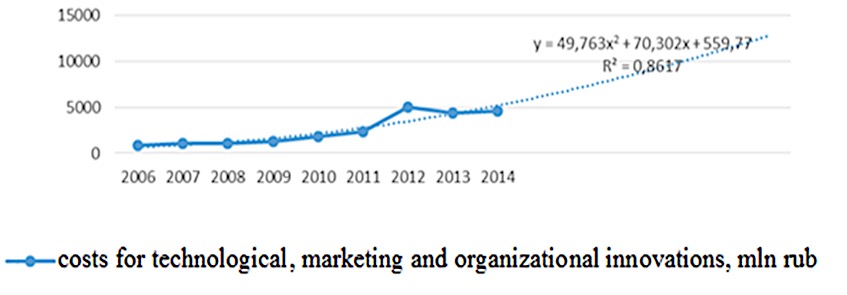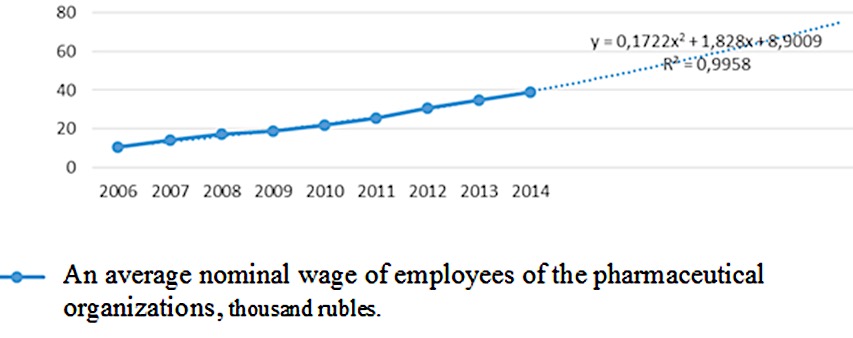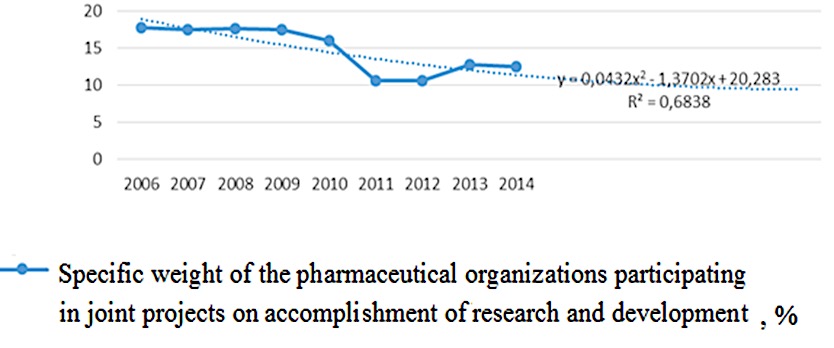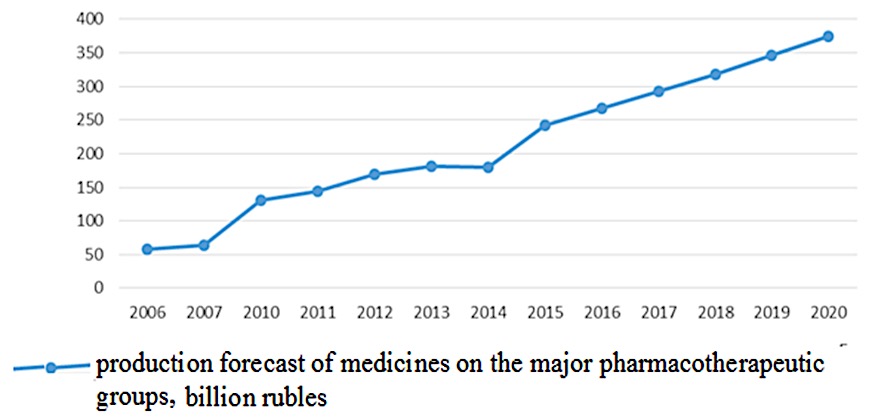Abstract
This article carries out assessment of external factors which influence the entities of pharmaceutical industry. The correlation model is constructed and the actual factors influencing development of pharmaceutical production are revealed. The regression model reflecting the dependence of amounts of release of pharmaceutical products on the change of factors of an external environment in dynamics from 2006 to 2014 is constructed. The realistic scenario of the production scope change for major pharmaceutical groups is constructed. The interrelation between macrofactors of the Russian pharmaceutical industry development and the amounts of its production are confirmed and measured in the research. This research is a reason for discussion and further studying of development of reasonable recommendations in order to change or refine the state industrial policy. The directions of further researches are connected with deeper studying of causes of relationships between production volumes and macrofactors, as well as with the assessment of time distribution of macroeconomic consequences of purposeful impact on a size of the considered factors.
Keywords: Innovative activityinnovative developmentmodelexternal environment factorspharmaceutical industry
Introduction
Today the Russian pharmaceutical industry is one of the high-tech industries of economy. According to researches of Higher School of Economics, the share of innovatively active pharmaceutical entities and organizations constitutes 29,3%. The Russian pharmacotherapeutical market is one of the most dynamic and fast-growing markets in the world. The final sale price of pharmaceutical products increases annually.
According to the forecasts shown in "The concept of long-term social and economic development of the Russian Federation for the period till 2020", the volume of the Russian pharmaceutical market by 2020 will reach 1,5 trillion rubles.
However, today the pharmaceutical industry is characterized by a set of unresolved problems and draws more and more attention of experts and government officials. Production of the "branded" generics is common for the entities. Therefore, the final consumer overpays for trade names of the medicines often obsolete and having lost their clinical efficiency.
Product portfolios of domestic pharmaceutical producers for the most part consist of low-profitable generics that does not allow producers to allocate more than 1-2% of the revenue for scientific researches and developments, wherein currently, domestic producers provide only 20% of necessary substances for pharmaceutical industry.
Lack of substances is covered with import. In our research on import volumes of pharmaceutical products, it is established that for the period 2006-2014, the import substitution coefficient which is calculated as a ratio of the amount of internal production to import has increased slightly ― from 0,34 to 0,37.
World Trade Center data were used in assessment of import volumes; the conversion in rubles used the annual average US dollar exchange rate published by the Bank of Russia.
Against this background, the Russian pharmaceutical industry almost was not presented at the world market, which was characterised by low export volume medicines and pharmaceutical substances. Today the Russian pharmaceutical industry is unable to provide the Russian market with main nomenclature of modern medicines produced entirely on the Russian territory.
Methods
The objective of this research is identification of external environment factors influencing development of the entities of pharmaceutical industry for the evolvement of strategic directions for further development. Detection of the external factors influencing the development of the pharmaceutical entities is an important problem, as questions of import substitution under the conditions of trade and financial restrictions and high volatility of imported items in light of ruble exchange rate fluctuations require short-term prioritization of directions.
Correlation and regression analysis has been applied to determine key macro factors influencing development of the entities in pharmaceutical industry under macroeconomic environment. Its task consisted in estimating the extent of influence of external environment factors to increase the production of major pharmaceutical groups.
In the course of this research, the political, economic, social and demographic, technology, international factors influencing the development of pharmaceutical production were identified. On the whole, about 44 macro-factors have been counted.
The indicator "Production of medicines on major pharmacotherapeutic groups" characterizing the size of the Russian pharmaceutical market has been chosen as resultants
During execution of analysis, some methodological assumptions significant for interpretation were considered. So, the correlation and regression analysis was carried out at the undisplaced level because of the short duration of temporary ranks and due to the need of empirical confirmation of a hypothesis of availability of interrelation between factors and a resultant indicator for further researches.
The greatest pair correlation between them and a resultant indicator criterion was defined for selection of macro-factors for further research.
The constructed correlation model has revealed close connection of a resultant indicator with such factors as "Costs for technological, marketing and organizational innovations" (coefficient of correlation of r = 0,92), "An average monthly nominal accrued payroll on an industry" (r = 0,94), "Share of the pharmaceutical entities and organizations participating in joint (including foreign) projects on accomplishment of research and development " (r =-0,82). Statistical data for creation of the regression model are shown in table
If positive correlation of "Y" according to "X1" and "X2" in general is natural and does not need additional comments, then negative interrelation of production volumes and a share of the producers participating in NIR can be interpreted in several ways:
- costs of Research and Development contributed to the diversion of working capital at the expense of the production or marketing program;
- costs for Research and Development replaced costs for the innovations and productivity of work influencing positively production;
- Patents as results of joint R&D were registered abroad where corresponding production takes place, without introduction of the appropriate production technologies in Russia.
Answers to the questions posed about actual reasons of a negative impact from a factor of "X3" can be received as a result of application of algorithms of identification of causes and effect relationships, such as Granger causality test which algorithm of application is described and approved. For confirmation of our assumption of positive influence of two factors х1, х2 and negative influence of factor х3, the regression model has been constructed. The analysis of macro environmental factors influencing development of pharmaceutical production in the received regression model has allowed us to reveal trends of key factors of a macro environment and to construct a real model in the form of a formula:
у = 94,654565 + 0,000762 x1+3,74937 x2 - 4,244768 x3, (1)
where:
х1 – expenses for technological, marketing and organizational innovations, mln rubles;
х2 – monthly average employees compensation within the organizations occupied in the production of pharmaceutical products, one thousand rubles;
х3 – share of the pharmaceutical organizations participating in joint (including foreign) projects on R&D, %.
To explain observed interrelations, we can say that innovations are the drivers to increased working performance; innovations also stimulate production growth. The X2 variable is the derivative indicator of work production gain (with adjustment of inflation growth). The negative impact of the third factor can be explained by the disadvantage manifested by the inefficiency of joint research projects.
As dimension of the variables included in model does not match, the solution of a question of comparative extent of their influence on a resultant indicator can be received as a result of research of the standardized coefficients of regression (beta coefficients).
In the standardized representation, the model constructed at the undisplaced levels looks as follows:
у = 0,026 x1+0,73 x2 - 0,264 x3. (2)
It is obvious that the compensation rise provides the greatest contribution to positive change in production of pharmaceutical products in Russia, when the volume of costs of innovations has much less influence on a resultant indicator. An increase in a share of the producers participating in joint scientific surveys during the observed period eliminates up to 36% of a positive effect from performance improvement of work.
Research of the considered macro-factors, namely their contribution to an import substitution by replacement of an indicator of production volume of medicines with the coefficient of import substitution allows us to arrive at one significant conclusion: the compensation rise acts as an inhibitor of growth rates of amounts of internal production of medicines, and costs for innovations and joint R&D project costs have crucial importance in those proportions which are described in equation (3):
у =13,373 x1 - 4,286 x2 + 8,564 x3. (3)
As the scenario determines a strategy of the industry where external environment factors change, the realistic scenario is constructed in this research. Values of factors of the external environment according to the realistic scenario were predicted by means of extrapolation, proceeding from the assumption of consistency of the tendencies of a stage of a macroeconomic cycle designated below, and the purposes of the state industrial policy and objectives of the state industrial policy.
The approximation coefficient (R ²) became a criterion of the choice of the result. The factor for х1, х2, х3 trend lines is constructed by means of a polynomial method since it is having a higher value of the coefficient of approximation in comparison with a logarithmic and linear method (fig. 1, fig. 2, fig. 3).



Results & Discussion
The results of calculations of forecast values of strategic factors received by means of creations of trend lines are provided in Table
Determination of the production of medicines in the major pharmacotherapeutic groups according to the realistic scenario was performed by the substitution of the received values of key factors in the real (regression) model (1). The obtained data are provided in fig.

According to the obtained results, it is possible to draw a conclusion that if the tendency of development of the considered indicators will continue, then by 2020, the production volume of medicines in the major pharmacotherapeutic groups increases to 374 billion rubles. In spite of this fact, data of the forecast of specific weight of the pharmaceutical organizations participating in joint projects on performance of a scientific research show negative dynamics
If the tendency remains the same, then by 2020, the share of the organizations participating in joint R&D projects decreases to 9,4%. One more revealed factor, which is positively influencing pharmaceutical production, is a compensation level of workers. In final calculations values, the growth of this indicator is observed. Costs for technological, marketing, organizational innovations also grow that demonstrates creation of conditions for innovative development of an industry.
Conclusion
The tools of an initial assessment of the external environment factors influencing the development of pharmaceutical production in Russia are tested. The actual external factors influencing the development of the pharmaceutical entities are revealed, and alternative interpretations of the received results as a result of replacement of a resultant indicator with the coefficient of import substitution are provided. The realistic production forecast by major pharmaceutical groups, taking into account the influence of the revealed actual strategic factors, is constructed.
The interrelation between macro factors of the Russian pharmaceutical industry development and the amounts of its production are confirmed and measured in the research. This research is a reason for discussion and further studying of development of reasonable recommendations in order to change or refine the state industrial policy.
The directions of further researches are connected with deeper studying of causes of relationships between production volumes and macro factors, as well as with the assessment of time distribution of macroeconomic consequences of purposeful impact on a size of the considered factors.
References
- Gorodnikova, N., Hochberg, L. (2015). Indicators of innovation statistical yearbook. Higher School of Economics, 87-99.
- Healthcare in Russia (2012). Federal State Statistics Service, 106-128.
- Healthcare in Russia (2013). Federal State Statistics Service, 92-114.
- Healthcare in Russia (2014). Federal State Statistics Service, 108-118.
- Healthcare in Russia (2015). Federal State Statistics Service, 112-148.
Copyright information

This work is licensed under a Creative Commons Attribution-NonCommercial-NoDerivatives 4.0 International License.
About this article
Publication Date
20 July 2017
Article Doi
eBook ISBN
978-1-80296-025-9
Publisher
Future Academy
Volume
26
Print ISBN (optional)
Edition Number
1st Edition
Pages
1-1055
Subjects
Business, public relations, innovation, competition
Cite this article as:
Borscheva, N., Polyakova, A., Fedorova, Y., & Yurieva, E. (2017). Assessment of Strategic Factors Influencing Development of Pharmaceutical Production. In K. Anna Yurevna, A. Igor Borisovich, W. Martin de Jong, & M. Nikita Vladimirovich (Eds.), Responsible Research and Innovation, vol 26. European Proceedings of Social and Behavioural Sciences (pp. 92-98). Future Academy. https://doi.org/10.15405/epsbs.2017.07.02.12

